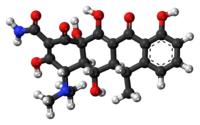Medical use
- Treatment of Lyme disease
- Treatment of chronic prostatitis
- Treatment of sinusitis
- Treatment of pelvic inflammatory disease
- Treatment of rickettsial infections
Antibacterial
- Effective against Moraxella catarrhalis
- Effective against Brucella melitensis
- Effective against Chlamydia pneumoniae
- Effective against Mycoplasma pneumoniae
- Some strains of Pseudomonas aeruginosa have developed resistance
Antimalarial
- Active against erythrocytic stages of Plasmodium falciparum
- Not active against gametocytes
- Used in the treatment of malaria
- Can be used as prophylaxis against malaria
- Targeting a plastid organelle, the apicoplast
Side effects
- Diarrhea
- Nausea
- Vomiting
- Abdominal pain
- Increased risk of sunburn
Commercial use and availability
- Patented in 1957
- Came into commercial use in 1967
- Included in the World Health Organization's List of Essential Medicines
- Available as a generic medicine
- 79th most commonly prescribed medication in the United States in 2020 with over 9 million prescriptions
Doxycycline is a broad-spectrum antibiotic of the tetracycline class used in the treatment of infections caused by bacteria and certain parasites. It is used to treat bacterial pneumonia, acne, chlamydia infections, Lyme disease, cholera, typhus, and syphilis. It is also used to prevent malaria. Doxycycline may be taken by mouth or by injection into a vein.
 | |
 | |
| Clinical data | |
|---|---|
| Pronunciation | /ˌdɒksɪˈsaɪkliːn/ DOKS-iss-EYE-kleen |
| Trade names | Doxy, Doryx, Vibramycin, others |
| AHFS/Drugs.com | Monograph |
| MedlinePlus | a682063 |
| License data |
|
| Pregnancy category |
|
| Routes of administration | By mouth, intravenous |
| ATC code | |
| Legal status | |
| Legal status | |
| Pharmacokinetic data | |
| Bioavailability | ~100% |
| Protein binding | 80–90% |
| Metabolism | Negligible |
| Elimination half-life | 10–22 hours |
| Excretion | Mainly feces, 40% urine |
| Identifiers | |
| |
| CAS Number | |
| PubChem CID | |
| DrugBank | |
| ChemSpider | |
| UNII | |
| KEGG | |
| ChEBI | |
| ChEMBL | |
| CompTox Dashboard (EPA) | |
| ECHA InfoCard | 100.008.429 |
| Chemical and physical data | |
| Formula | C22H24N2O8 |
| Molar mass | 444.440 g·mol−1 |
| 3D model (JSmol) | |
| |
| |
| | |
Common side effects include diarrhea, nausea, vomiting, abdominal pain, and an increased risk of sunburn. Use during pregnancy is not recommended. Like other agents of the tetracycline class, it either slows or kills bacteria by inhibiting protein production. It kills malaria by targeting a plastid organelle, the apicoplast.
Doxycycline was patented in 1957 and came into commercial use in 1967. It is on the World Health Organization's List of Essential Medicines. Doxycycline is available as a generic medicine. In 2020, it was the 79th most commonly prescribed medication in the United States, with more than 9 million prescriptions.
Blend of d(e)oxy- + oxy(tetra)cycline.
doxycycline (uncountable)